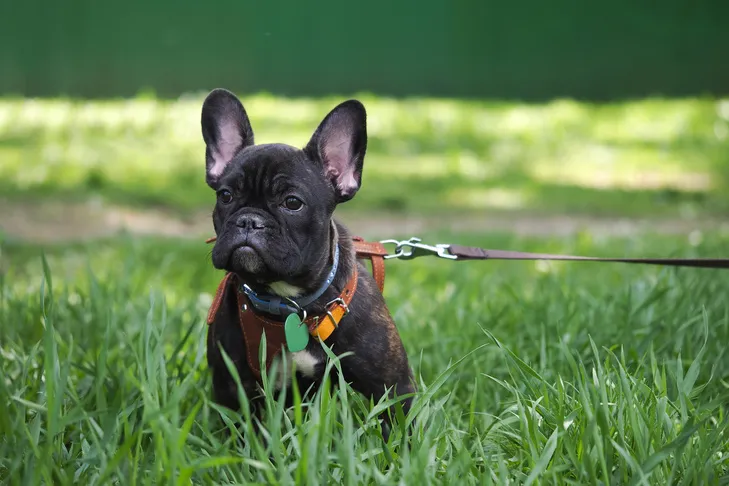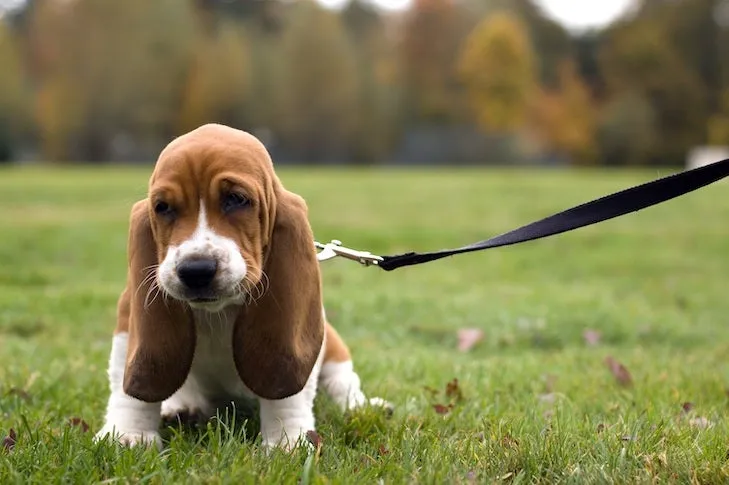Many new dog owners assume that puppies instinctively know how to walk politely on a leash. However, like many other aspects of good canine behavior, mastering the leash is a learned skill that requires dedicated training. It’s a fundamental skill that will enhance every walk and outing with your dog, making it a valuable investment of your time. Building a strong foundation for leash manners from an early age is crucial for a well-behaved companion. A properly leash-trained dog is not only a joy to walk but also better equipped for advanced training, such as learning to train your puppy for emotional support.
Dog training expert Kathy Santo shares essential tips to help your puppy get accustomed to a leash and enjoy walks by your side. These methods focus on positive reinforcement and gradual introduction, ensuring a comfortable and confident experience for your furry friend.
Training Your Puppy to Walk on a Leash
Establishing a solid foundation for leash walking involves several key steps that build on each other, moving from indoor practice to the great outdoors.
Introduce Your Puppy to the Collar or Harness and Leash
Begin by making the collar, harness, and leash positive objects for your puppy. Let them wear these items for brief periods inside the house. During this time, engage them in play and offer plenty of treats. The goal is for your puppy to associate collar-and-leash time with enjoyable activities and rewards. This initial conditioning helps prevent any negative associations and sets a positive tone for future training.
Teach a Cue
Introduce a consistent sound cue that signifies an incoming treat. This could be a clicker sound, a simple word like “yes,” or even a specific tongue cluck. The method remains the same: in a quiet, distraction-free environment, with your puppy wearing their collar and leash, make the chosen sound. The instant your puppy acknowledges you by turning or looking your way, reward them with a treat. After several repetitions, your puppy will not only look at you but also eagerly come towards you for the treat, connecting the sound directly to a positive outcome. This responsive behavior is a stepping stone towards more complex tasks like learning to train your dog to help with anxiety.
 French bulldog puppy in a harness sitting in tall green grass on a leash for a walk.
French bulldog puppy in a harness sitting in tall green grass on a leash for a walk.
Make the Puppy Come To You
Once your puppy understands the cue, encourage them to come to you. While they are on their way, still wearing the leash and collar, take a few steps backward. Reward them generously with a treat and praise when they reach you. Gradually increase the number of steps you take backward, working towards a sequence where your puppy, upon hearing the cue, comes and walks a few paces alongside you. Remember that puppies have short attention spans, so keep training sessions brief and enjoyable, always ending on a positive note before they become mentally fatigued.
Practice Inside
With your puppy now understanding how to respond to your call, it’s time to practice walking a few steps in a low-distraction indoor environment. Simply feeling the leash and collar around them will provide enough of a challenge at this stage. Continue to offer treats and verbal praise as your puppy learns to walk with you while on a leash. This indoor practice builds their confidence and reinforces the desired behavior in a controlled setting before encountering the complexities of the outside world. Developing a strong bond through basic training can also pave the way for specialized skills, such as learning to train your dog to do deep pressure therapy.
Take It Outside
Finally, you are ready to introduce your puppy to the great outdoors. This step presents new challenges due to the multitude of intriguing sights, sounds, and smells. Be patient and keep initial outdoor walks short. It is essential to remain vigilant, constantly observing your puppy’s reactions. If your puppy appears poised to lunge towards something or gets distracted, make your cue sound and move a few steps away. Reward them with a treat for following you, redirecting their attention and reinforcing that good things happen when they focus on you, even amidst distractions. This early exposure helps them develop crucial focus.
 Basset Hound puppy sitting in the grass on lead.
Basset Hound puppy sitting in the grass on lead.
Leash-Training Troubleshooting
Even with a strong foundation, puppies and adult dogs may encounter issues with leash walking as they mature, explore new environments, and face novel distractions. Training for loose-leash walking is vital for a pleasant experience for both you and your dog, and is often a prerequisite for advanced certifications like the Canine Good Citizen test. Here are practical tips to address common leash training challenges. Effective training in these areas contributes to a well-behaved dog, ready for roles like learning to train your dog as a service dog.
If Your Puppy Pulls
When your dog begins to pull in the opposite direction, immediately stop moving and “become a tree.” Stand completely still and refuse to budge until your dog returns to your side and loosens the leash. Avoid yanking or jerking the leash, or dragging your dog along. For persistent pullers, alternative training tools such as front-hook harnesses and head halters can be highly effective, as they discourage pulling by redirecting the dog’s momentum.
If Your Puppy Lunges
If your dog tends to lunge at specific targets during walks—such as other dogs, cars, or skateboarders—proactive intervention is key. Attempt to redirect their attention with a treat before they have the opportunity to lunge. Increase the distance between your dog and the perceived trigger, staying alert and prepared well in advance of the target getting too close. While this behavior can be more common in herding breeds due to their natural instincts, any dog can be startled or over-excited by new stimuli. This preventative approach also lays groundwork for more complex behaviors, like how to teach your dog deep pressure therapy.
If Your Puppy Barks
Some dogs develop a habit of barking excessively at other dogs during walks. This behavior is often linked to a lack of sufficient mental and physical stimulation. Ensure your dog receives an appropriate amount of exercise for their age and breed. If barking persists, employ a similar strategy as for lunging: create distance from the trigger and offer treats before the barking starts. Consistently rewarding calm behavior when another dog is present will help your puppy learn to shift their attention to you instead of reacting negatively.
Over time, as your puppy masters leash manners, you will gradually reduce the frequency of treats and troubleshooting during walks. However, it’s always a good practice to keep some treats on hand for random reinforcement of excellent leash-walking behavior. This intermittent reinforcement helps maintain consistent positive habits.
Conclusion
Teaching your puppy how to get used to a leash is a foundational step in responsible dog ownership, ensuring safer and more enjoyable walks for both of you. By following a systematic approach that introduces the leash positively, establishes clear cues, practices in controlled environments, and gradually transitions to the outdoors, you can build your puppy’s confidence and skills. Addressing common challenges like pulling, lunging, and barking with patience and consistent redirection will further solidify their good behavior. With dedication and positive reinforcement, your puppy will soon become a well-mannered walking companion, ready for any adventure. For more in-depth guidance on various dog training topics, consider exploring the wealth of resources available to help you and your furry friend thrive.
